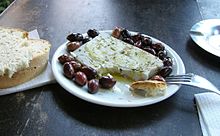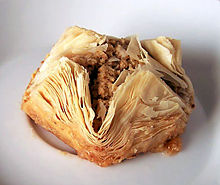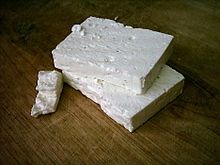Greek cuisine

Greek cuisine (Greek: Ελληνική Κουζίνα) is Greece's traditional cuisine. It is a typical Mediterranean cuisine[1] sharing similar characteristics with the cuisines of Southern France, Italy, the Balkans, Anatolia, and the Middle East.
Overview

The most characteristic and ancient element of Greek food is olive oil, which is present in almost every dish. It is produced from the trees prominent throughout the region, and adds to the distinctive taste of Greek food. The basic grain in Greece is wheat, though barley is also grown. Important vegetables include tomato, aubergine, potato, green beans, okra, green peppers, and onions. Honey in Greece is mainly flower-honey from the nectar of fruit and citrus trees (lemon, orange, bigarade trees), thyme honey, and pine honey from conifer trees. Mastic is grown on the Aegean island of Chios.
Greek cuisine uses some flavourings more often than other Mediterranean cuisines do: oregano rigani, mint dhiosmo, garlic, onion, dill, salt, and bay laurel leaves. Other common herbs and spices include basil, thyme and fennel seed. Many Greek recipes, especially in the northern parts of the country, use "sweet" spices in combination with meat, for example cinnamon and cloves in stews. Greek flavour is often characterised by the use of mint and nutmeg. Other typical ingredients are lamb, pork, kalamata olives, feta cheese, grape leaves, zucchini and yogurt. The desserts are dominated by nuts and honey.[1]
The terrain has tended to favour the breeding of goats and sheep over cattle, and thus beef dishes are more rare. Fish dishes are also common, especially in coastal regions and on the islands. A great variety of cheese types are used in Greek cuisine, including Feta, Kasseri, Kefalotyri, Graviera, Anthotyros, Manouri, Metsovone and Mizithra. Some dishes use phyllo pastry.
Too much refinement is generally considered to be against the hearty spirit of the Greek cuisine, though recent trends among Greek culinary circles tend to favour a somewhat more refined approach. Typical Greek food is simple, colorful and packed with robust flavours. Many dishes show influences from the Greek past, having a distinctive style of their own which has not changed much over the years. Greek cuisine has a long tradition of fine cooking and the full range of Greek dishes usually remains undiscovered by the tourist.[2]
Origins

Contemporary Greek cookery is typical of Mediterranean cuisine, making wide use of olive oil, grains and bread, wine, fish, and various meats, including poultry and rabbit.[1] Greece has an ancient culinary tradition dating back several millennia, and over the centuries Greek cuisine has evolved and absorbed numerous influences and influenced many cuisines.
Legend has it that Klephtico (or Kleftiko) slow cooked lamb (or other meat) can be translated as 'stolen meat'. The Klephts, not having flocks of their own, would steal lambs or goats and cook the meat in a sealed pit to avoid the smoke being seen.
Some dishes can be traced back to ancient Greece: trahanas, skordalia, lentil soup, retsina, pasteli; some to the Hellenistic and Roman periods: loukaniko; and Byzantium: feta cheese, avgotaraho, paximadi. There are also many ancient and Byzantine preparations which are no longer consumed: porridge as the main staple, fish sauce nuc mam, salt water mixed into wine, etc.
Many dishes' names come from the Ottoman cuisine tradition and their names reveal Arabic, Persian or Turkish roots such as moussakas, baklavas, tzatziki, yuvarelakia, keftethes. Many dishes' names probably entered the Greek vocabulary during Ottoman times, but there was earlier contact with the Persians and the Arabs. Some dishes may be pre-Ottoman, only taking Turkish names later; Ash and Dalby, for example, speculate that grape-leaf dolmathes were made by the early Byzantine period.[3][4]
A few dishes are influenced by Venetian (Italian) cuisine, such as pastitsio, makaronia me kima, though pasta with meat together is considered in culinary circles as an "eastern" tradition, found mostly in Greece and Anatolia and Asia Minor and regions of that influence.
Recently, fast-food has also become more popular in Greece and Europe, with local chains such as Goody's springing up. Although fast food is gaining popularity and many major fast-food chains have opened all over Greece, the Greek people still rely primarily on the rich and extensive dishes of the Greek cuisine. In addition, some traditional Greek foods, especially souvlaki, gyros, pita/pites, for example tiropita and spanakopita (savory or sweet stuffed phyllo dough) are often served in fast food style.
Dining out has always been common in Greece.[citation needed] The Taverna and Estiatorio are widespread, serving traditional Greek home cooking at affordable prices to both locals and tourists.
Typical dishes
As mentioned above, Greek cuisine is very diverse and although there are many common characteristics amongst the culinary traditions of different regions within the country, there are also many differences, making it difficult to present a full list of representative dishes. Just to give an example, the vegetarian dish " Haniotiko Mpoureki" (oven baked slices of potatoes with zucchini, myzithra cheese and mint) is a typical dish in the region of Chania (western Crete), which a family may consume 1-2 times per week in the summer season. However, it is not cooked in any other region of Greece.
In the following section, there is an attempt to list some of the most representative Greek dishes that can be found throughout the country and the most famous of the local ones.
Appetizers


Meze is a collective name for a variety of small dishes, typically served with wine, ouzo or homemade tsipouro. Dips are served with loaf bread or pita bread. In some regions, dried bread (paximadhi) is softened in water. Orektika is the formal name for appetizers and is often used as a reference to eating a first course of a cuisine other than Greek cuisine.
- Boureki: individually wrapped vegetable and meat fillings in phyllo pastry or dough.
- Deep Fried vegetables "tiganita" (courgettes, aubergines, peppers or mushrooms).
- Dolmades: grapevine leaves stuffed with rice and vegetables, meat is also often included.
- Fava: Yellow split pea puree or other bean purees; sometimes made of fava beans (called κουκκιά in Greek)
- Greek Salad: The so-called Greek Salad is known in Greece as Village/Country Salad (Horiatiki).
- Horta: wild or cultivated greens, steamed or blanched and made into salad, simply dressed with lemon juice and olive oil. They can either be eaten as a light meal with potatoes (especially during Lent, in lieu of fish or meat).
- Kolokythoanthoi: zucchini flowers stuffed with rice or cheese and herbs.
- Koukkia: fava beans.
- Lachanosalata: Cabbage Salad. Very finely shredded cabbage with salt, olive oil, lemon juice/vinegar dressing.
- Marides tiganites: Deep-fried whitebait, usually served with lemon wedges.
- Melitzanosalata: aubergine (eggplant) salad.
- Pantzarosalata: beetroot salad with olive oil and vinegar.
- Patata salata: Potato salad with olive oil, finely sliced onions, lemon juice or vinegar.
- Saganaki: fried cheese; the word "saganaki" means a small cooking pan, and can be applied to many other foods.
- Skordalia: thick garlic and potato puree, usually accompanies deep fried fish/cod.
- Spanakopita: spinach wrapped in phyllo pastry.
- Taramosalata: fish roe mixed with boiled potatoes or moistened breadcrumbs.
- Tzatziki: yoghurt with cucumber and garlic puree, used as a dip.
- Tyropita: cheese (usually feta) wrapped in phyllo pastry.
- Many other things are wrapped in phyllo pastry, either in bite-size triangles or in large sheets: kotopita (chicken), spanakotyropita (spinach and cheese), hortopita (greens), kreatopita (meat pie, using ground meat), etc.
Soups
- Avgolemono 'egg-lemon' soup: chicken, meat, vegetable, or fish broth thickened with eggs, lemon juice, and rice.
- Bourou-Bourou, a vegetable & pasta soup from the island of Corfu.
- Colomo soup.
- Fakes, is a lentil soup and one of the famous everyday Greek soups, usually served with vinegar and feta cheese.
- Fasolada, a bean soup defined in many cookery books as the traditional Greek dish. It is made of beans, tomatoes, carrot, celery and a lot of olive oil.
- Magiritsa, is the traditional Easter soup made with lamb offal and thickened with avgolemono.
- Patsas, a tripe soup.
- Psarosoupa 'fish soup' can be cooked with a variety of fish types, and several kinds of vegetables (carrots, parsley, celery, potatoes, onion), several varieties include the classic kakavia which is drizzled with olive oil.
- Revithia, a chickpea soup.
- Trahana soup.
Vegetarian main dishes
- Aginares A La Polita: artichokes with olive oil.
- Arakas Me Aginares: fresh peas with artichokes in the oven.
- Bamies: okra with tomato sauce (sometimes with potatoes and/or chicken/lamb).
- Fasolakia freska: fresh green beans stewed with potatoes, zucchini and tomato sauce.
- Gigantes beans: baked butter beans with tomato sauce and various herbs.
- Horta (greens) already mentioned in the Appetizers section, are quite often consumed as a light main meal, with boiled potatoes and bread.
- Lachanodolmades: Cabbage rolls, stuffed with rice and sometimes meat, spiced with various herbs and served with avgolemono sauce or simmered in a light tomato broth.
- Spanakorizo: Spinach and rice stew cooked in lemon and olive oil sauce.
- Yemista: Baked stuffed vegetables. Usually tomatoes, peppers, or other vegetables hollowed out and baked with a rice and herb filling.
Meat dishes

- Baked lamb with potatoes (Αρνί στο φούρνο με πατάτες). One of the most common Greek dishes. There are many variations with additional ingredients.
- Bekri Meze: 'drunkard's snack', diced beef marinated in wine, cloves, cinnamon, bay leaves, olive oil and cooked slowly.
- Giouvetsi: baked lamb in clay pot with Kritharaki - orzo.
- Grilled lamb chops (païdakia) with lemon, oregano, salt and pepper.
- Grilled octopus in vinegar, oil and oregano. Accompanied by Ouzo.
- Gyros: meat roasted on a vertically turning spit and served with sauce (often tzatziki) and garnishes (tomato, onions) on pita bread; a popular fast food.
- Kleftiko: literally meaning "of the Klephts", this is lamb slow-baked on the bone, first marinated in garlic and lemon juice, originally cooked in a pit oven.
- Keftedes: fried meatballs with oregano and mint.
- Kotopoulo pilafi ('Chicken Pilaf'), mostly popular on the island of Crete.
- Moussaka: eggplant casserole. There are other variations besides eggplant, such as zucchini or rice, but the eggplant version melitzanes moussaka is most popular.
- Pastitsio: a baked pasta dish with a filling of ground meat and a Bechamel sauce top.
- Pork with celery (hirino me selino/hirino selinato).
- Soutzoukakia Smyrneika: large meatballs with cumin, cinnamon and garlic and served in a tomato sauce.
- Souvlaki: (lit: 'skewer') Anything grilled on a skewer (lamb, chicken, pork, swordfish, shrimp). Most common is lamb, pork or chicken, often marinated in oil, salt, pepper, oregano and lemon.
- Spetsofai: a dish with country sausages, peppers, onions and wine. Originates from Mt. Pelion.
- Stifado: game (rabbit, venison etc.)stew with pearl onions, red wine and cinnamon.
Desserts and sweets


- Baklava, a popular sweet middle eastern dessert, of phyllo pastry layers with nuts, sugar, syrup, honey and cloves.
- Diples, a Christmas and wedding delicacy, made of thin, sheet-like dough which is cut in large squares and dipped in a swirling fashion in a pot of hot olive oil for a few seconds. As the dough fries, it stiffens into a helical tube; it is then removed immediately and sprinkled with honey and crushed walnuts.
- Galaktoboureko, custard between layers of phyllo. The name derives from the Greek "ghala", meaning milk, and from the Turkish börek, meaning filled, thus meaning "filled with milk."
- Halvadopites A nougat of sesame with almonds in a thin crust.
- Karidopita, a walnut cake.
- Koulourakia, butter or olive-oil cookies.
- Kourabiedes, Christmas cookies made by kneading flour, butter and crushed roasted almonds, then generously dusted with powdered sugar.
- Loukoumades, similar to donuts, loukoumades are essentially fried balls of dough drenched in honey and sprinkled with cinnamon.
- Melomakarona, "honey macaroons", Christmas cookies soaked in a syrup of diluted honey (meli in Greek, thus melomakarona), then sprinkled with crushed walnuts.
- Moustalevria, a flour and grape must pudding.
- Moustokouloura, cookies of flour kneaded with fresh grape must instead of water.
- Ravani, is a golden yellow cake made with farina or semolina and topped with a light sugar/honey or orange-flavored syrup.
- Rizogalo 'rice-milk' is rice pudding.
- Loukoumi is a confection made from starch and sugar, essentially similar to the Turkish delight. A variation from Serres is called Akanes.
- Milopita me Pandespani, apple pie with cinnamon and powdered sugar.
- Spoon sweets (γλυκά του κουταλιού) of various fruits, ripe or unripe, or unripe nuts. Spoon sweets are essentially made the same way as marmalade, except that the fruit are boiled whole or in large chunks.
- Tsoureki, a traditional Christmas and Easter sweet bread also known as 'Lambropsomo' (Easter bread), flavored with "mahlepi", the intensely aromatic extract of the stone of the St. Lucie Cherry.
- Vasilopita, Saint Basil's cake or King's cake, traditional for New Year's Day. Vasilopites are baked with a coin inside, and whoever gets the coin in their slice are considered blessed with good luck for the whole year.
- Yogurt with honey or spoon sweet syrup.
Cheese

There is a wide variety of cheeses made in various regions across Greece. The vast majority of them remain unknown outside the Greek borders due to the lack of adequate advertising and the highly localized distinctive features. Many artisanal cheeses, both common varieties and local specialties, are produced by small family farms throughout Greece and offer distinct flavors atypical of the mass produced varieties found commercially in Greece and abroad. A good list of some of the varieties of cheese produced and consumed in Greece can be found in the List of cheeses article, under the name of the country. Here are some of the more popular throughout Greece:
Drinks
- Wine is the most common drink in Greece. Legend claims that wine was invented on the island of Icaria.
- Beer is widely drunk; common brands include Vergina, Heineken, Amstel, Zeos, Mythos, Alfa Hellenic Lager, Fix, Henninger, and Kaiser, all of which are produced locally, some under license.
- Ouzo (an 80-proof clear alcoholic beverage that is flavored with anise; it turns milky white with water or ice; the best said to be produced on the island of Lesbos).
- Tsipouro or (esp. in Crete) tsikoudia/raki (Mostly home-brewed, a clear drink similar to ouzo, often with higher alcohol content, and usually not flavored with herbs. The city of Volos at the centre of Greece is well-known for its Tsipouradika (literally: tsipouro places). In Thessaly tsipouro is always flavored with anise.
- Retsina (a white wine that has some pine resin added, originally as a preservative, but nowadays for the flavor; this is an Athens region specialty. It should not be aged.).
- Mavrodafni Sweet, liquor-style, red wine with higher alcohol percentage than normal.
- Metaxa, a brand of sweet brandy, 40% alcohol content.
- Greek coffee, made by boiling finely ground coffee beans, and is served thick and strong, and often sweetened.
- Greek frappé coffee a foam-covered drink derived from spray-dried instant coffee that is consumed cold.
See also
References
- Andrew Dalby, Siren Feasts: A History of Food and Gastronomy in Greece, London, 1996. ISBN 0-415-11620-1. (Mostly about ancient and Byzantine food.)
Notes
External links
- Epikouria Magazine Devoted to the fine foods and drinks of Greece.
- Kerasma, a Greek quango promoting Greek cuisine.
- http://www.gnto.gr/pages.php?pageID=467&langID=2, the Greek National Tourism Organization's website
